The Featured Page will put a spotlight on the greats of the Silver and Golden Era’s of Bodybuilding. The page will be used to bring attention to a particular bodybuilder or contest each quarter. The page will be populated by consolidating all the articles and photo’s from within the vast and ever growing database of this magnificent bodybuilding website. So keep checking in regularly as a different bodybuilder will be featured each quarter. Don’t hesitate to drop us an email if you want one of your favorites featured on this page.

STRAIGHT TALK WITH ROGER WALKER (APRIL 2025)
‘TONNES PER HOUR’ THE TRAINING SECRETS BEHIND ROGER WALKER’S 1980 MR OLYMPIA PHYSIQUE.
As an ongoing feature I am proud to announce that I will be sharing extracts from my conversations with one of the true greats of the golden era of bodybuilding. Roger Walker will be giving you the “straight talk”. Everything he says will be straight from the hip.
In this the premier edition of STRAIGHT TALK WITH ROGER WALKER we will share the training philosophy that he employed to reach the peak of his powers at the controversial 1980 Mr Olympia. Most of what follows is straight the Herculean Walker’s mouth!
Roger is a class act, a true gentleman and his candid and honest approach is refreshing.
With that I present:
STRAIGHT TALK WITH ROGER WALKER
Before we get to Roger’s 1980 training methods it is important to prelude what is to come with a bit of history. Roger highlights 4 key training blocks of his early development before going into detail of his “TONNES PER HOUR” methodologies. Lets begin at the start.
EARLY YEARS
Roger left home and joined the royal marines at the age of 14. The physical regiment of the marines was a perfect grounding for the development of a world class physique. Whilst in the cadets there was a mandatory requirement to participate in an athletic pursuit. After a short stint in the fencing club Roger would join the circuit club. The circuit consisted of about 12 free weight stations and included but was not limited to sit ups, chin ups, push ups and burpees. At about the age of 16 Roger progressed to the military base gym. It was an aerobic gym, not a weight training gym. It had ropes that hung from the roof, wall bars attached to one side of the room and a huge box that contained loose weights, dumbbell handles and bars that sat in the centre of the room. Roger would go on to explain “If you wanted to do bench, you’d have to take the top off of the vaulting horse and lay there on your back and if there’s someone around you would ask them to pull the weight up to you. So with chin ups you’d have to climb up a double set of wall bars. Stand on the top of the highest wall bar and then reach out for one of the beams that went across roof line. With a little skip and a half jump you could just grab the bar. So you were like hanging 25 feet off the ground which means you never missed a rep. You had to save half a rep to swing back so you didn’t fall to the ground and suffer permanent injury.” After a couple more years of solid but haphazard training, primarily within the confines of the limited military base gym, he would compete in his very first competition. Roger was 19 at the time.
H.M.S. HERMES
Unfortunately, Rogers competitive career was then put on hold for a couple of years. He was deployed on active service. He was stationed on H.M.S. Hermes, an aircraft carrier vessel, deployed to sea. Roger was part of the ships Operational Band as a clarinet player. Roger goes on to explain “I finally got drafted to the Hemes, but unfortunately, that was the ship. And again, they had plenty of weights but nothing else, so I had to purchase my own equipment, a 7 in 1 bench and an inverted Weider Leg Press and some dreadfully, awful Weider 50lbs plates. The leg press was dangerous. It had 2 poles that were not supported by anything and you took your life into your own hands when you used it. If you put a lot of weight on it the whole thing would start swaying. I had to try and secure it with cable to brace it up like a mast. I could only do one leg at a time because I couldn’t get enough weight on it. It was close to useless. I used the rack on the 7 in 1 bench to do squats. At the time I was reading bodybuilding magazines and it was a process of continual evolution and refinement. I tested plenty to see what worked and what didn’t. There was nothing secret about it. Just trial and error. Just basic goal setting, dedication and hard work. I just went down to train and would come back a couple of hours later, absolutely dredged with sweat smelling of diesel fuel.” Roger jammed his makeshift gym between two lockers down near the bows of the ship. Not to be deterred, he trained under inconceivable conditions. All his training was done to the moving motion of the vessel with the weights varying up to and beyond a hundred pounds with the shifts in the sea. Further, the ship used diesel fuel as ballast to lower its centre of gravity and increase stability. Roger would have to train with two to three inches of fuel under his feet at all times and the air was eternally filled with the smell of the diesel fuel. Roger would end training session in a coughing fit from the smell.
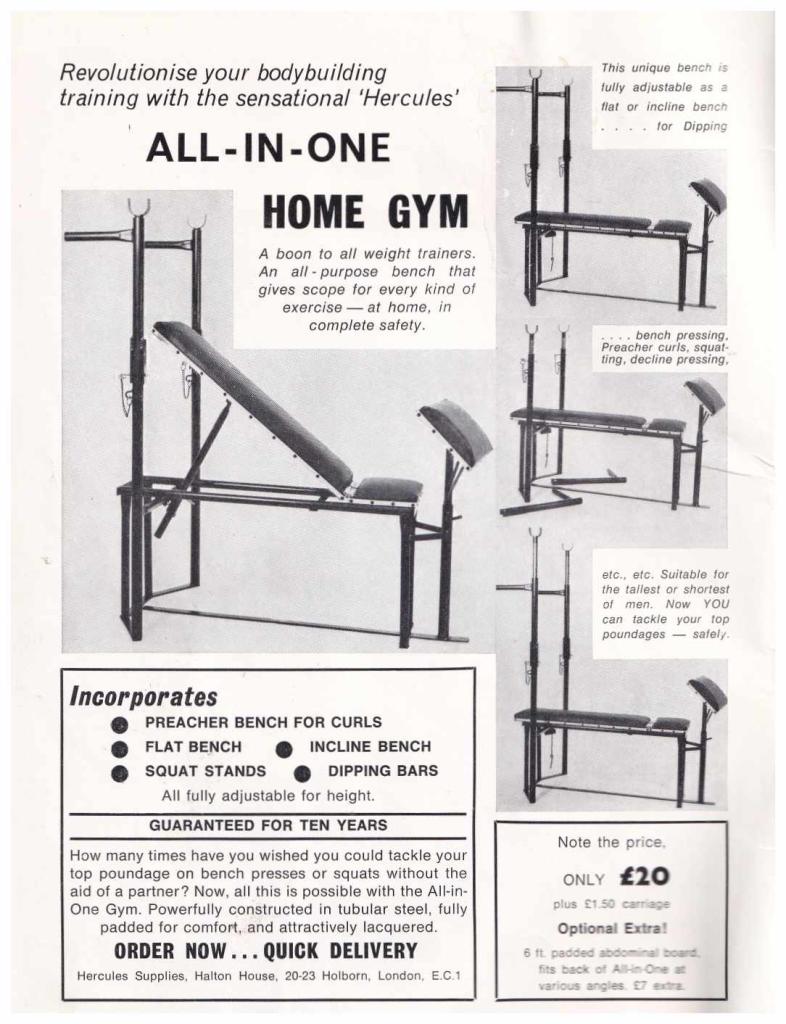
The All-In-One Hercules Home Gym advertisement from Health & Strength Magazine. Roger purchased this exact piece of gym equipment to take aboard the H.M.S. Hermes.
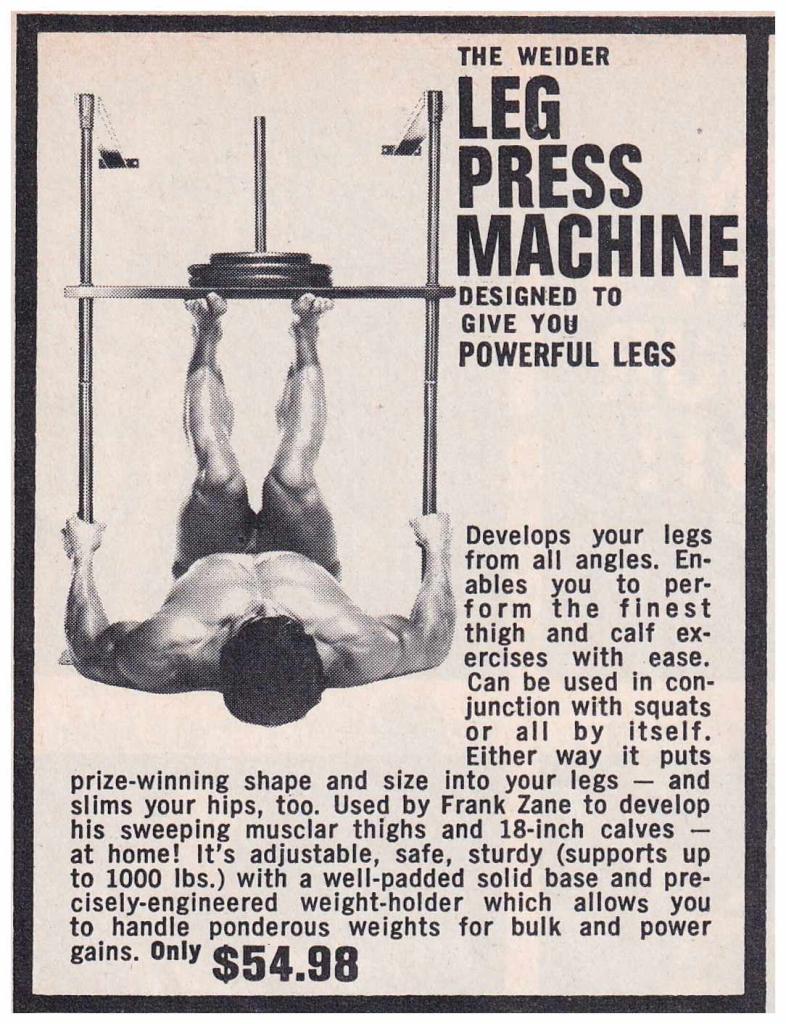
This is an advertisement for the Weider inverted leg press that Roger took aboard the H.M.S. Hermes. It was very dangerous and close to useless.
THE GORDON ALLEN YEARS
Gordon Allen was an exceptional regional bodybuilder known for having astonishing strength. This Portsmouth Bodybuilding strongman initially refined Arnold Schwarzenegger’s physique. It was at his Albert Road gym in the mid 60s that ‘The Austrian Oak’ was truly introduced to what real training was. Gordon would push Schwarzenegger to breaking point and far beyond anything the ‘wunderkind’ had previously dreamed brutally possible. Roger would now experience the same education. Gordon would take Roger’s training to a new level and the sessions were brutal. The intensity of effort had an immediate impact. Roger recalls “ Gordon Allen came on board the ship a couple of times to train with me. He was pushy and I was very shy. I knew he was Mr. South East UK and he was a big shot. I found him very intimidating initially, up to this point I had never trained in a gym with other bodybuilders. He invited me to train with him. It took a couple of weeks for me to build up the nerve to take up Gordon’s invitation. His gym wasn’t all that large and the equipment was very limited. Basic stuff really – a squat rack, bench press, standing calve machine, chin up bar, dip bar and a wall full of dumbbells, not much else. However, that was all that was needed as I won both Mr. England and Mr. U.K under Gordon’s intense tutorage.”
MOVE TO AUSTRALIA
“Once I moved to Australia it was a continual refinement of what I had learnt from Gordon Allen. I was stationed at a base in Richmond, New South Wales and once again my access to equipment was limited. There was a weight room about the size of a large bedroom. It had some Olympic parallel bars, a vaulting horse and a chinning bar that was held on the ceiling with rope, so it swung. Which actually turned out better because you had to do your chins really smoothly so that the bar didn’t swing. I think if we look at pictures of me at the Mr Asia, I have very low inserts on my lats when I did a double bicep or lat pose. I think retrospectively that came from when I did chins on that swinging rope. Does that make sense. So, I think it’s a fantastic way to do a chin. There is no jumpy or jerky movements and all that shit and I think it was how I was able to get my lat insertion so low.”
“Roman rings are also fantastic. Doing dips on those was unbelievable. You would really have to lock everything in. I wish I’d been able to utilise Roman rings in my later career, just because I think it’s a more natural movement. You really had to take control. It was like the old strongmen trained. No one does this these days. I think bodybuilding has gone soft!”
Rogers training would continue to evolve and be refined with a knowledge that only comes with time. His access to adequate equipment and training facilities improve as he ventured into International competition. Roger was training on a six-day, double split weekly routine. One body part in the morning and one in the late afternoon. His training was placed either side of his working day. Training was intense and heavy, a trademark throughout his career. Standing presses, 5 reps with 300lbs, 3 reps with 330lbs, a bench press of 490lbs and a squat of 660lbs. Roger could curl 100lbs dumbbells. Some exceptional poundage that was clearly reflected in his Herculean physique.
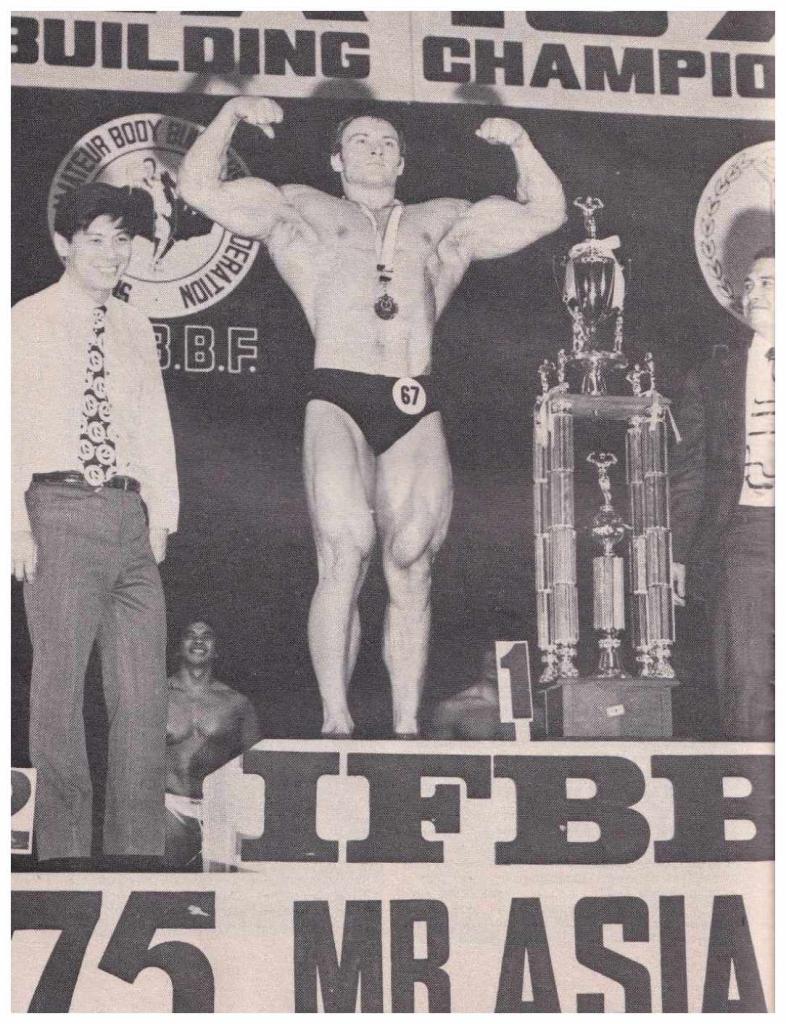
Roger winning the overall 1975 Mr Asia. Notice the low inserts on his lats. He largely attributes this to his chin ups on a swinging bar.
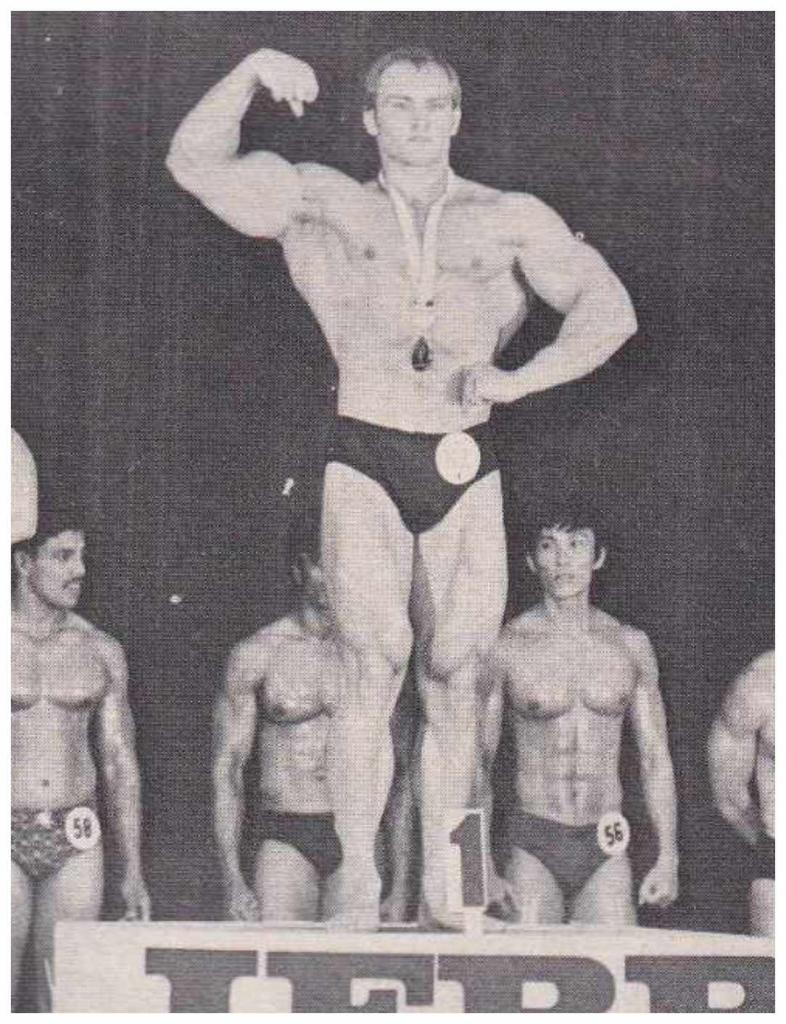
Another shot of the 1975 Mr Asia that illustrates the low lat insertions on Rogers physique.
‘TONNES PER HOUR’ AND MY QUEST FOR OLYMPIA GLORY!
“I was training in a fairly standard fashion, you know, with a training partner. My set, his set, my set, his set and so on. Then I though to myself I am spending ‘X’ number of hours in the gym and I began to questioned how much of that time I was actually doing any work.”
It was from these notions that Roger’s mentality shifted and his method of “Tonnes Per Hour” training was born! In preparation for the 1980 Mr Olympia Roger would train alone when the gym was empty so he had no distractions. He would now focus on four variables – weight, sets, reps and time in his quest for glory!
At this point I think it is prudent to briefly explain the mechanics and mathematics behind “Tonnes Per Hour Training”. It quiet simple really from a mathematical perspective:
(Weight x Reps x Sets) x (60 minutes / Minutes Trained) = Total Weight Per Hour
With a new mindset Roger ditched the training partner and was on his way.
“I decided not to decease the weights I used but to speed up using the same weights. If I sped up using the same weights, I would get more work done in a shorter period of time. Technically I’d be increasing the weights as I’m cutting down recovery time. Does that make sense! I then gradually started incorporating super-sets that meant I could go from one set without rest straight to the other, so I could get two sets in the space of one.”
Roger would not sacrifice form or tempo with the new demands of his training schedule. Each rep would be perfect anything short of this was unacceptable. Following is a sample of how he trained each body part:
CHEST ROUTINE:
Flat Dumbbell Bench Press and Flat Bench Flyes (Super-set 5 sets x 10 repetitions)
Incline Dumbell Bench Press and Weighted Dips (Super-set 5 sets x 10 repetitions)
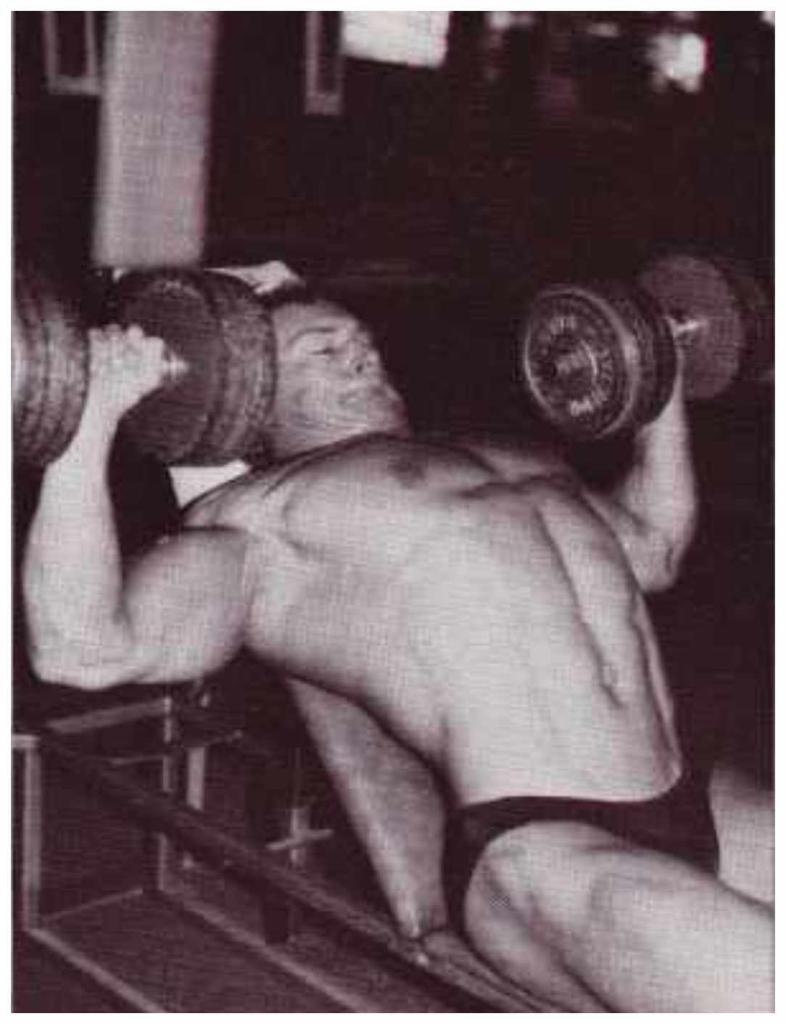
Incline Dumbell presses
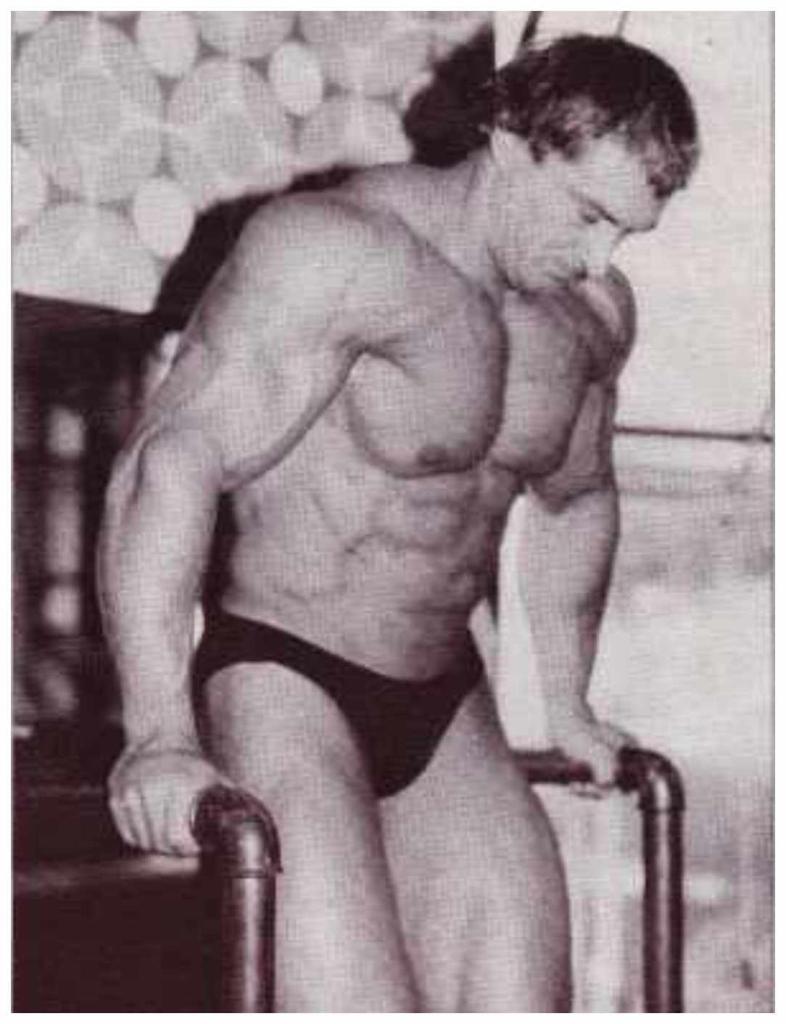
The dip was a cornerstone of Roger’s chest training regimen.

Bench Press
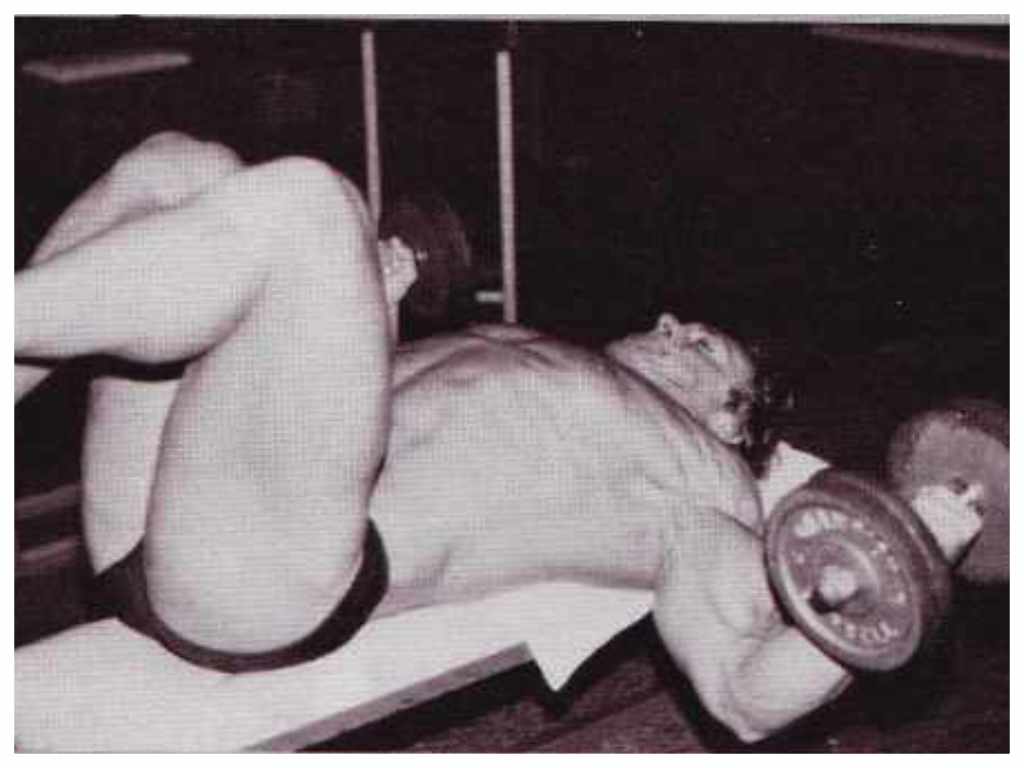
Dumbell Fyes
“So for example, if I was super-setting a dumbbell bench press with flies and I was doing the dumbbell bench press with, I don’t know, let’s call it the 100’s and I do 10 of those so that’s 1000 lbs per arm or 2000 lbs all up and then I immediately move onto fly’s. I’m doing the 50’s which is what 500 lbs per arm if I get 10, 1000 lbs all up. I then do 5 sets of the combination and I have moved 15,000 lbs. Then I do incline presses and dips. The inclines are using the same 100 lbs dumbbells that I was doing flat presses with. With the dips I’m doing bodyweight plus a dumbbell. Once again, it’s another 5 sets. 2000lbs for each set of the incline presses and 2500lbs for a set of dips. 5 sets of this superset add up to 22,500 lbs. So that’s 10 supersets in 20 minutes. Then I would finish off with a couple of sets of straight arm pullovers just to stretch out the rib box. I moved 37,500 lbs in 20 minutes for chest at a rate of 112,500 lbs per hour! This equates to over 56 tonnes per hour!”
“To increase the overall hourly poundage all I would have to do is add one more rep, or 10 lbs of weight or decrease the rest fractionally. So I had a choice on how to increase my productivity. I have reps, time and weight. I have a choice of 3 to make improvements. So its not necessary to necessarily increase the weight. Does this make sense. You have to build up to it. This is quiet difficult.”
BACK ROUTINE:
Weighted Chin Ups and Bent Over Rows (Superset 5 sets x 10 repetitions)
Lat Pulldown and Seated Rows (Superset 5 sets x 10 repetitions)
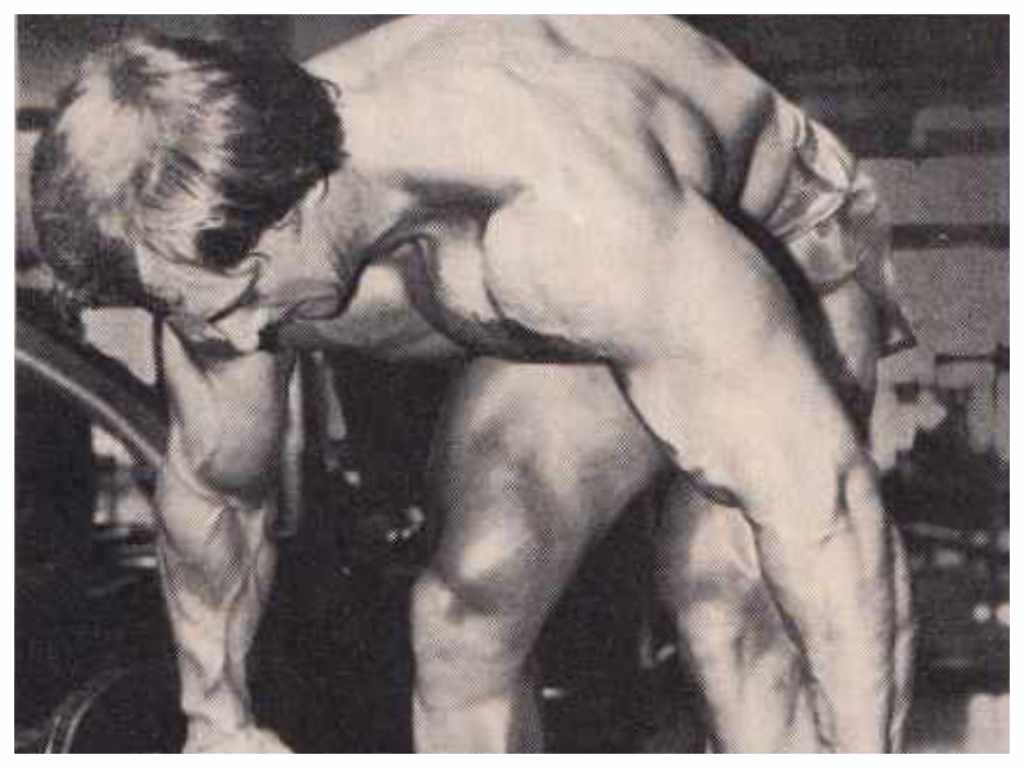
Bent Over Rows were like digging holes in the road!
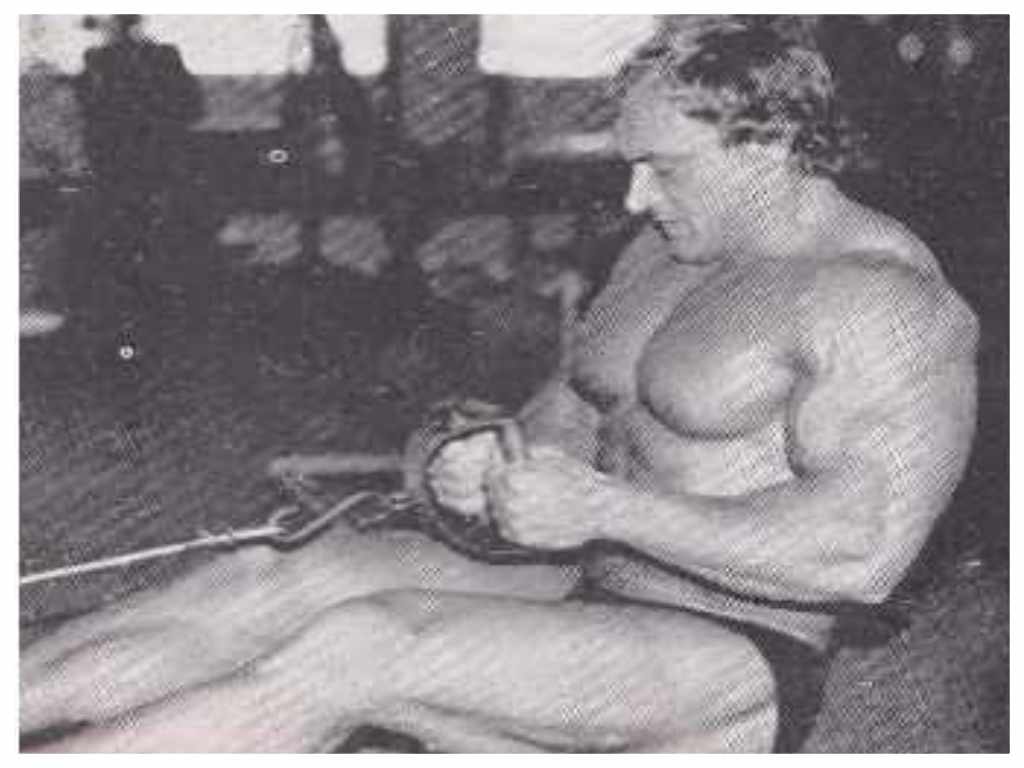
Cable Row
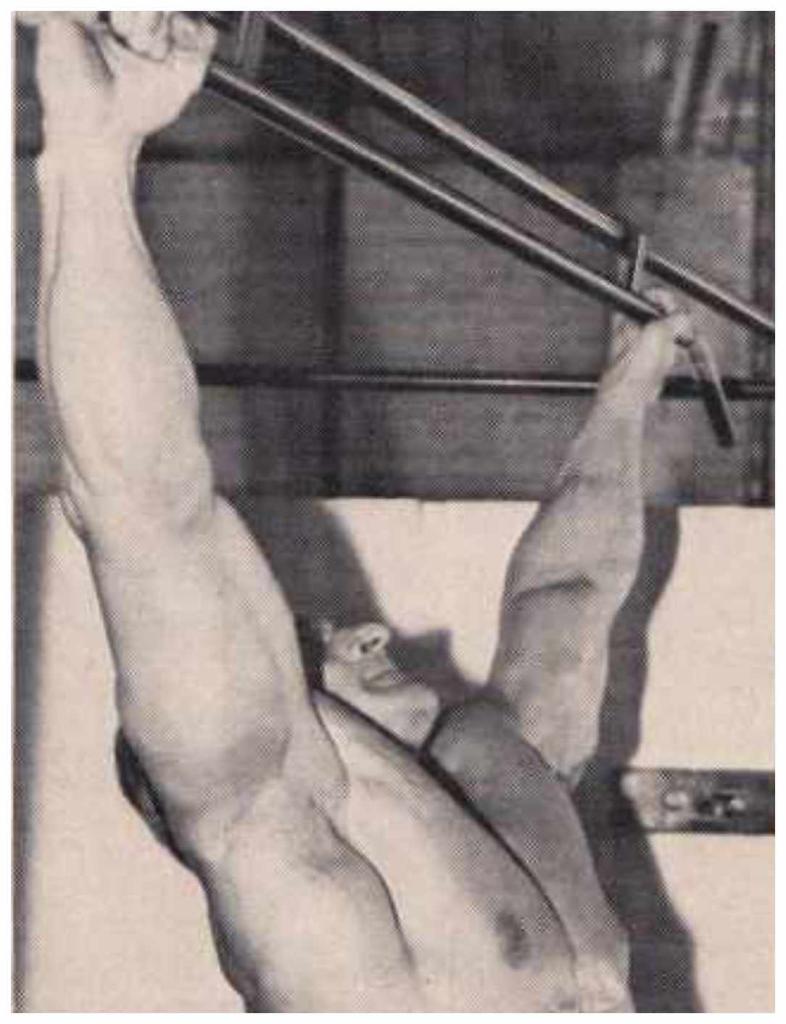
The cornerstone of any back routine is the chin up.

It is important to arch your back and reach a full contraction at the top of your chin up.
“For Back I would superset chins and bent over rows for 5 sets. Bent over rows was like digging holes in the road. Very demanding. I would use about 250lbs or something as that was all I needed to get a benefit. It was enough. The chins would be weighted. The next superset was lat pulldowns and seated rows. The machine stack for both of them. Around 200lbs on both, 5 sets of 10 reps.”
“Same principle as bench press and flyes. Cutting down the recovery is the same as adding weight without having to add weight. You get to a point in your training where you have to take a step back to avoid injury. You need to find another way. If you train the standard way and once you start getting into fairly heavy weight it starts moving you into the red zone all the time. You are pushing your engine into the red zone and it starts to get dangerous. Then you can pop something and you are in trouble. Like a racing car engine.”
“For example if your bench press is 500lbs and you start moving up to like say 450lbs, even if you are getting reps at this weight, it is getting progressively more dangerous as far as injury is concerned. If you move to my method you can still use plenty of weight but the weight increase is on every set as the recovery time is shortened and decreases. This way you use about 75% to 90% of a traditional training program weight for a safer outcome.”
“It is not easier but it is safer. There is no way you cannot get a pump because your body is screaming for oxygen. Therefore the capillaries you cant see have to grow to give you blood supply. If you force that need, it means that your body will grow including your capillaries, veins, arteries and everything else. But you have to create that demand. I didn’t do cardio deliberately as this is aerobic. My heart rate was bouncing along.”
“Today with the chemical stuff they use they don’t need to do what I did. They don’t need to train like that. A couple of half reps and then they could adjust their bandana and tap away at their phone.”
LEGS ROUTINE:
Seated Calves and Standing Calves (Super-set 10 sets x 20 repetitions)
Squats, Leg Extensions and Leg Curls (Tri-set 10 sets x 20 repetitions)
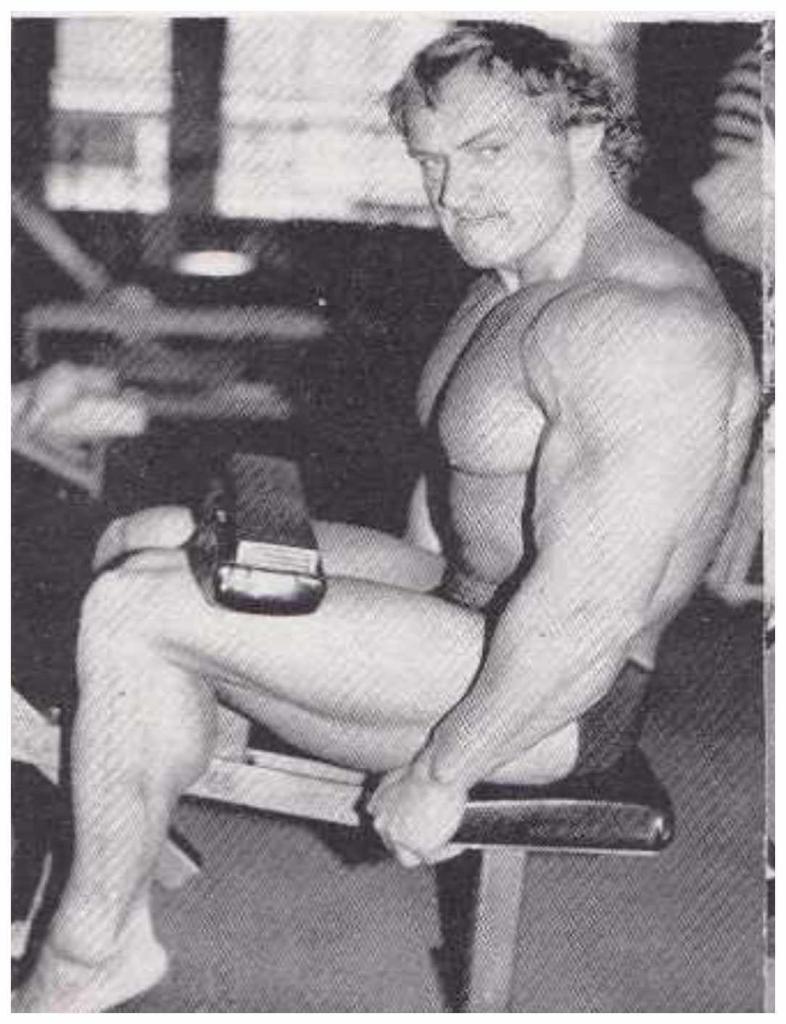
Roger always started his leg routine with calve training.
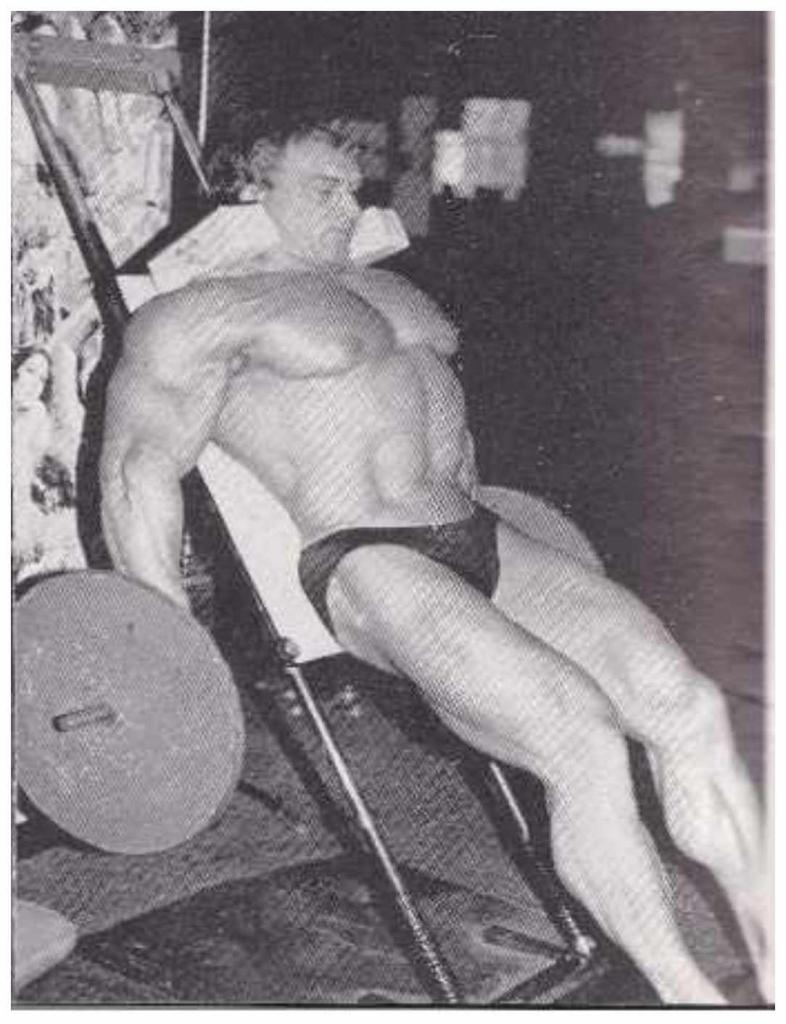
To improve the shape of his legs Roger would forgo the traditional squat for hack squats in his preparation for the 1980 Mr Olympia.
“For the 1980 Mr Olympia I stopped doing proper squats because I have English legs, they look like sausages. Roy Duval has English legs too. We had a problem shaping our legs, not getting them bigger. Big legs is easy. I did a tri-set of Hack Squats, leg extensions and leg curls. 20 reps each exercise in each tri-set. However, I would always start with calves. To get blood into your calves it needs to come from your thighs. If you do your thighs first, I mean properly do them, the last thing you want to do is stand under a calve machine. Your thighs should be wobbly by then, so always do you calves first. So thats not my idea thats a Gordon Allen thing. We always stated with calve work. For the 1980 Olympia I did seated and stranded calves that was it, 10 sets of each.”
SHOULDER ROUTINE:
Seated Shoulder Presses and Upright Rows (Superset 5 sets x 10 repetitions)
Front Raises, Side Raises and Bent-Over Raises (Tri-set 5 sets x 10 repetitions)
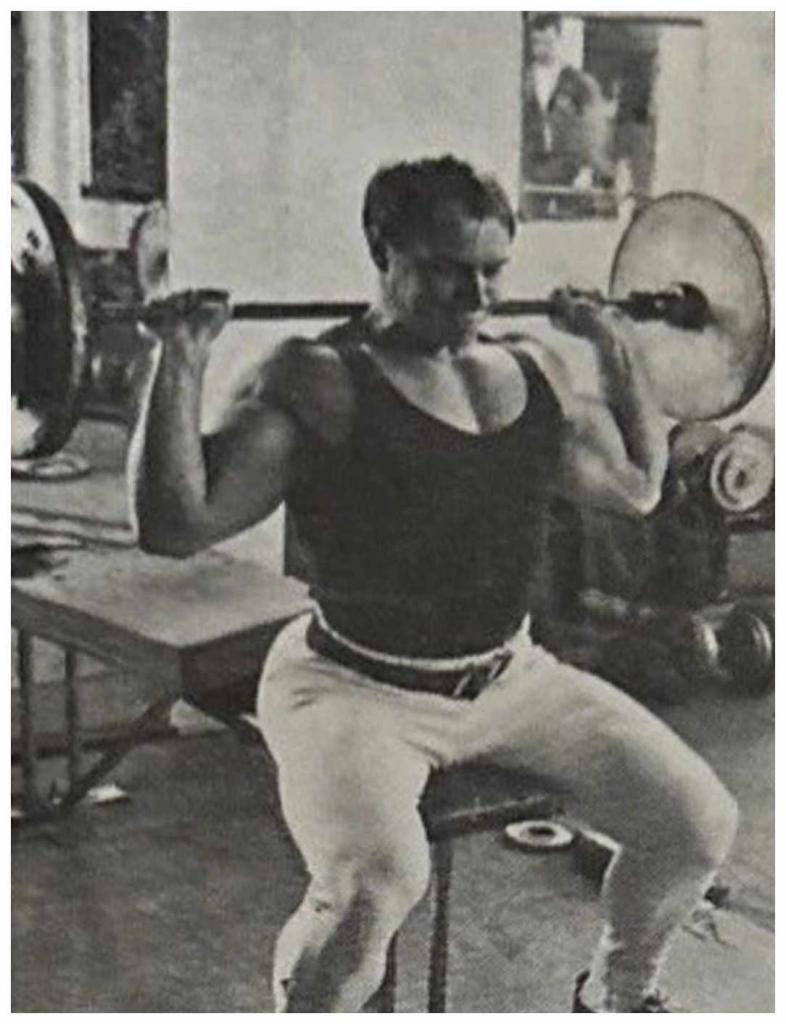
An early photo of Roger shoulder pressing in England under the tutorage of Gordon Allen.
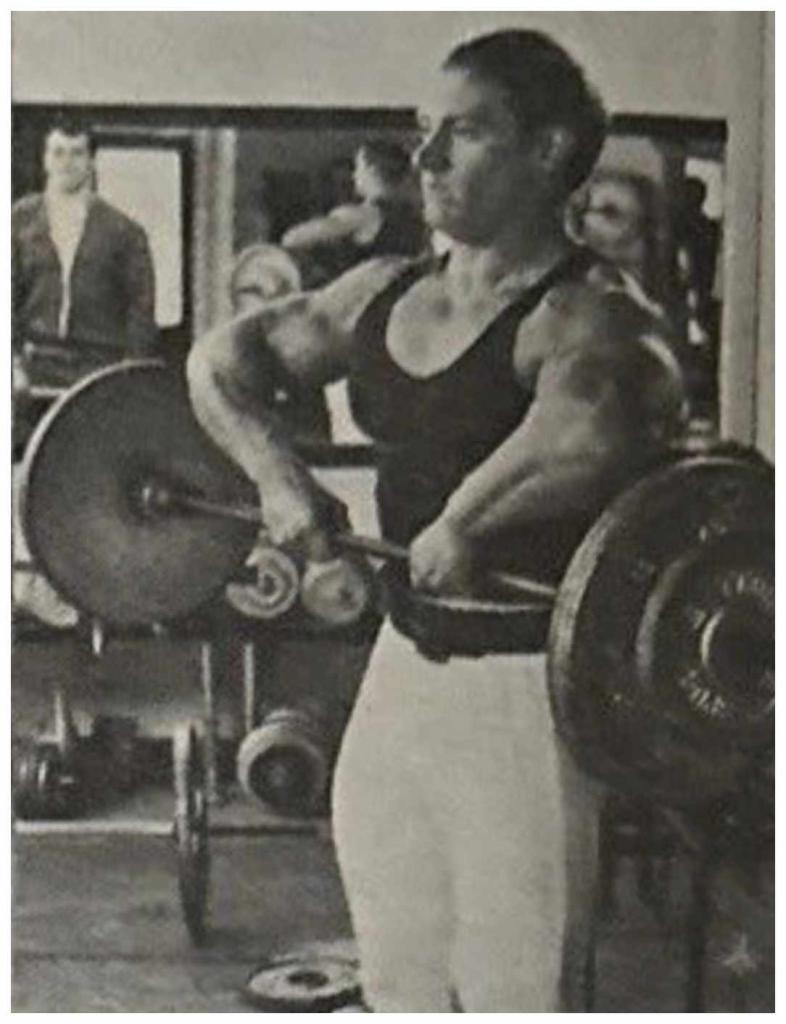
An early photo of Roger using the upright row to great effect in England under the tutorage of Gordon Allen.
“For Shoulders I would do a super-set of seated presses and upright rows and then I would do a tri-set of front raises, side raises and bent-over raises without putting the dumbbells down. It was done in a continuous fashion without actually releasing the dumbbells which was extremely painful. 5 sets of each.”
TRICEPS ROUTINE:
Lying Triceps, Standing Triceps and Tricep Pushdowns (Tri-set 5 sets x 10 repetitions)
“For Triceps I would do lying triceps, standing triceps and triceps pushdowns as a tri-set.”
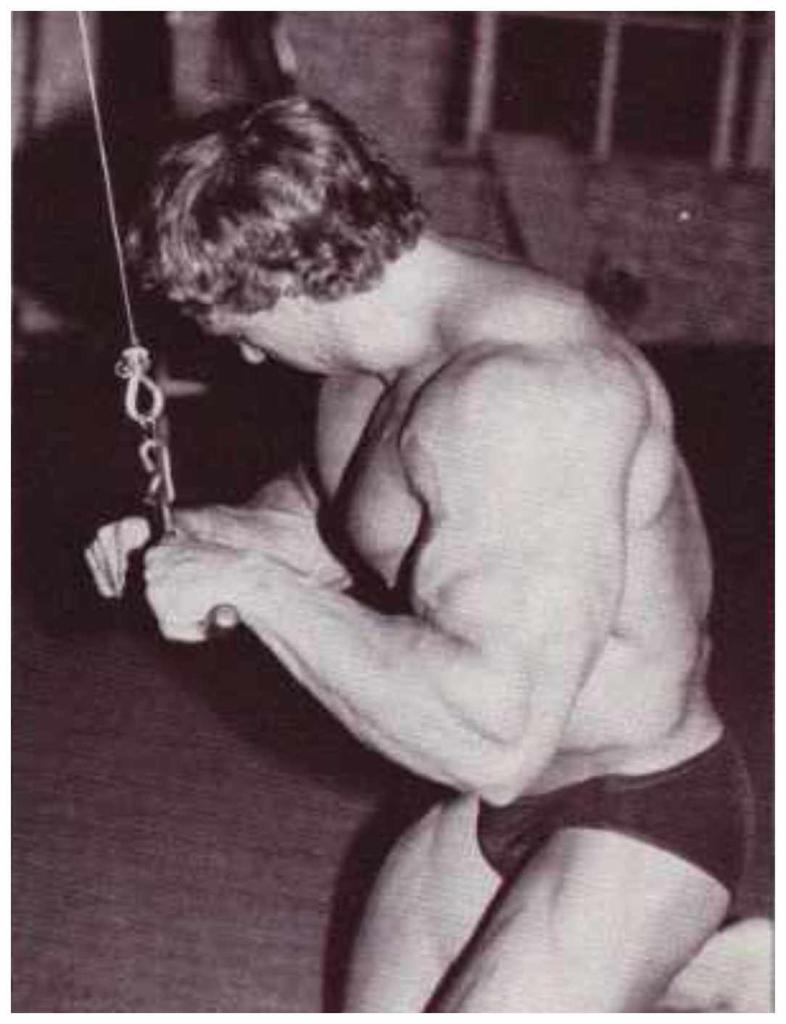
Tricep Pressdowns.
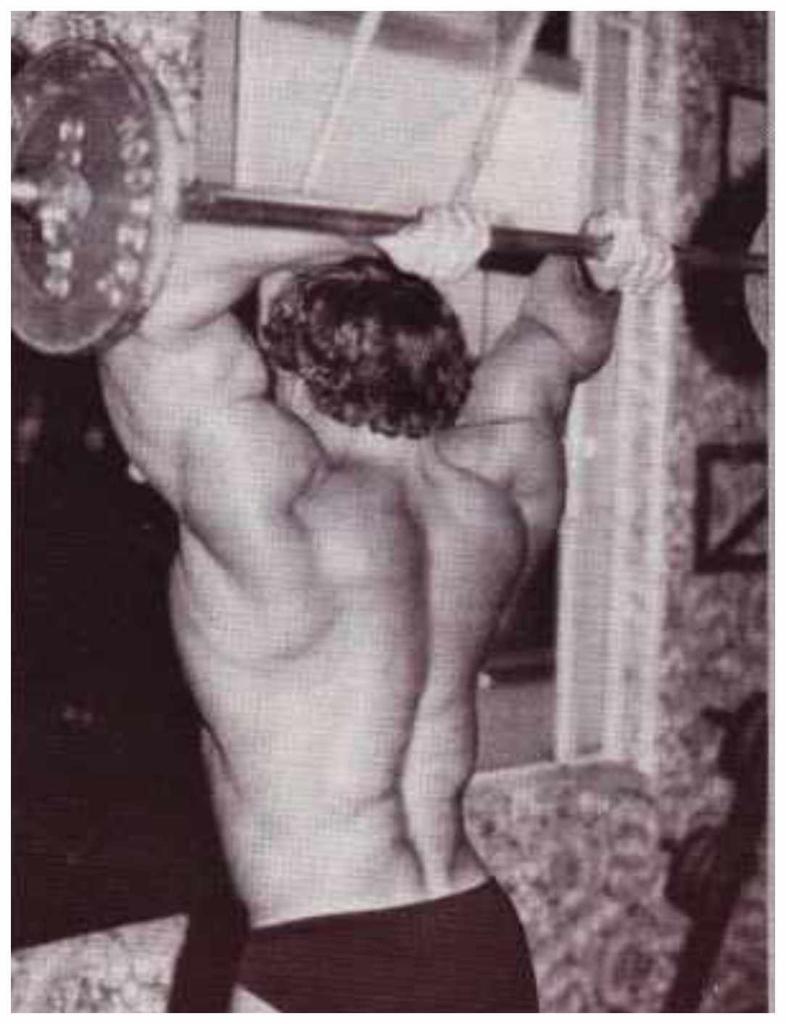
Tricep overhead extensions.
BICEPS ROUTINE:
Dumbbell Curls and Barbell Curls (Super-set 5 sets x 10 repetitions)
Reverse Curls and Concentration Curls (Super-set 5 sets x 10 repetitions)
“For biceps and forearms I would do dumbbell curls, barbell curls, reverse curls and concentration curls in various combinations of super-sets and tri-sets.”
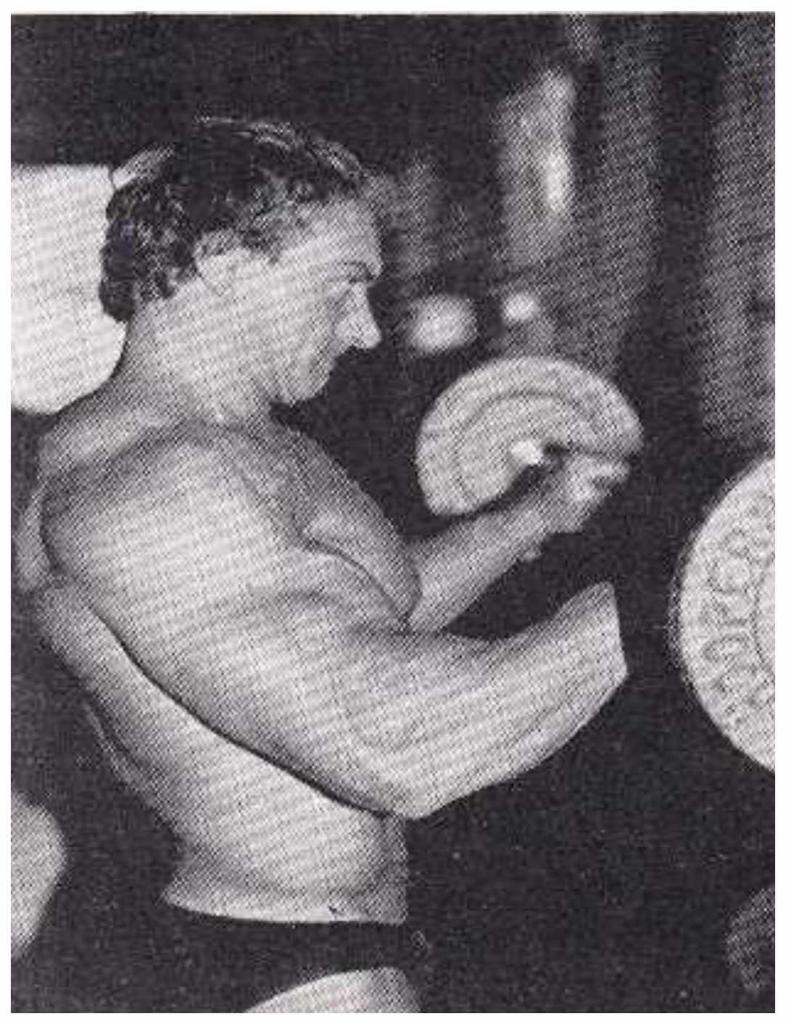
Barbell Curls.
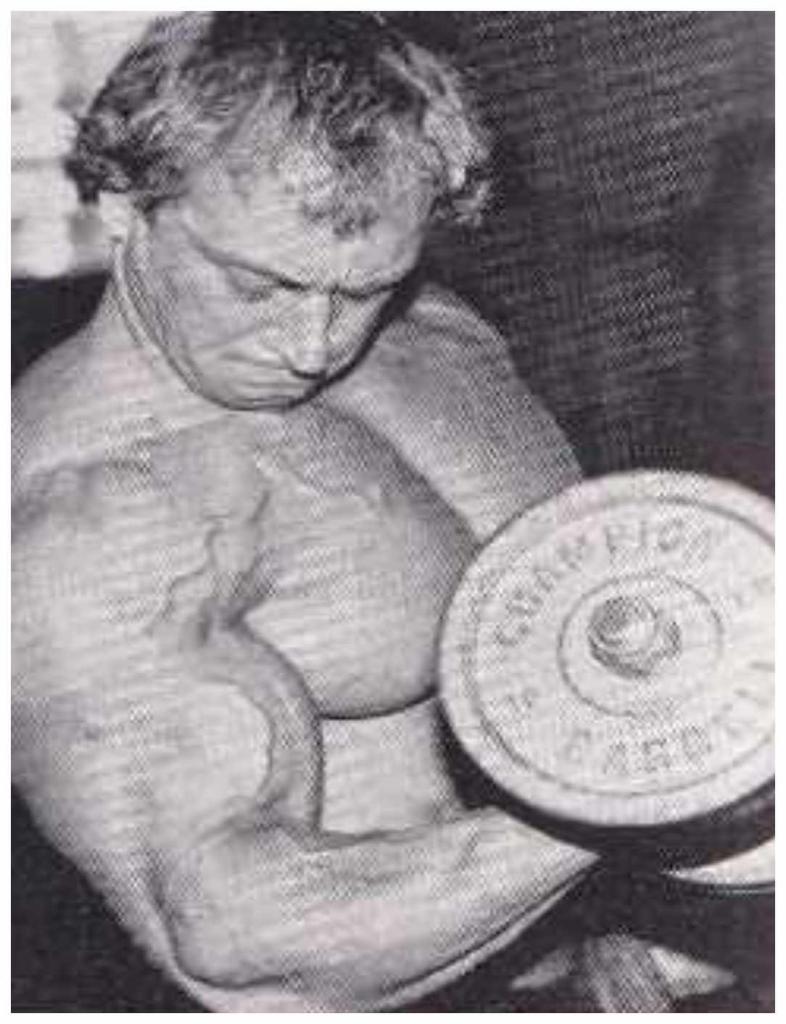
Dumbbell Curls.
ABDOMINAL WORK:
Roger would always incorporate some abdominal work at the end of each of his training sessions. It would generally consist of a combination of some sort of crunch and leg raise movement. He would work his abdominals for about 10 minutes.
“I finish my body part and then finish off with some ab exercises. I didn’t want to grow my abs so they were limited. I just wanted to hold them in flat. I had done thousands and thousands in the past.”
PROGRAM SPLIT:
DAY 1: CHEST AND TRICEPS
DAY 2: BACK AND SHOULDERS
DAY 3: LEGS AND BICEPS
“My split was as follows: Chest and triceps, Back and shoulders, Legs and Biceps. For a contest it was done as one body part in the morning and one in the afternoon. 6 to 7 days a week, especially in the last couple of weeks before a contest.”
“For the 1980 Olympia I got the balance perfect, I wasn’t shagging myself and I wasn’t using anymore gear than what I had used before. I was doing 3 Dianobol a day and 1 Decca every 3 weeks in the lead up to the competition. They would laugh at that now. Crazy! I found it a personal challenge, I didn’t like using gear but I had to use gear to a certain point to stay in touch with the opposition. In that time I think the gear used was a moderate and reasonable amount in most cases. A lot of these guys from the 1980 Olympia are still going. Most of them are still alive. We had limits.”
So there it is, Roger Walker’s 1980 Mr Olympia training program. Hope you enjoyed the read and got a little something out of the article that you can incorporate into your routine. I myself have commenced training in this fashion and the first few workouts have been incredible. Some of the best I have ever had. Roger has put together a “Civilian” version of his “Tonnes Per Hour” training routine and that will be shared in the next edition of STRAIGHT TALK WITH ROGER WALKER!
Until then train hard, be consistent and watch what you eat!
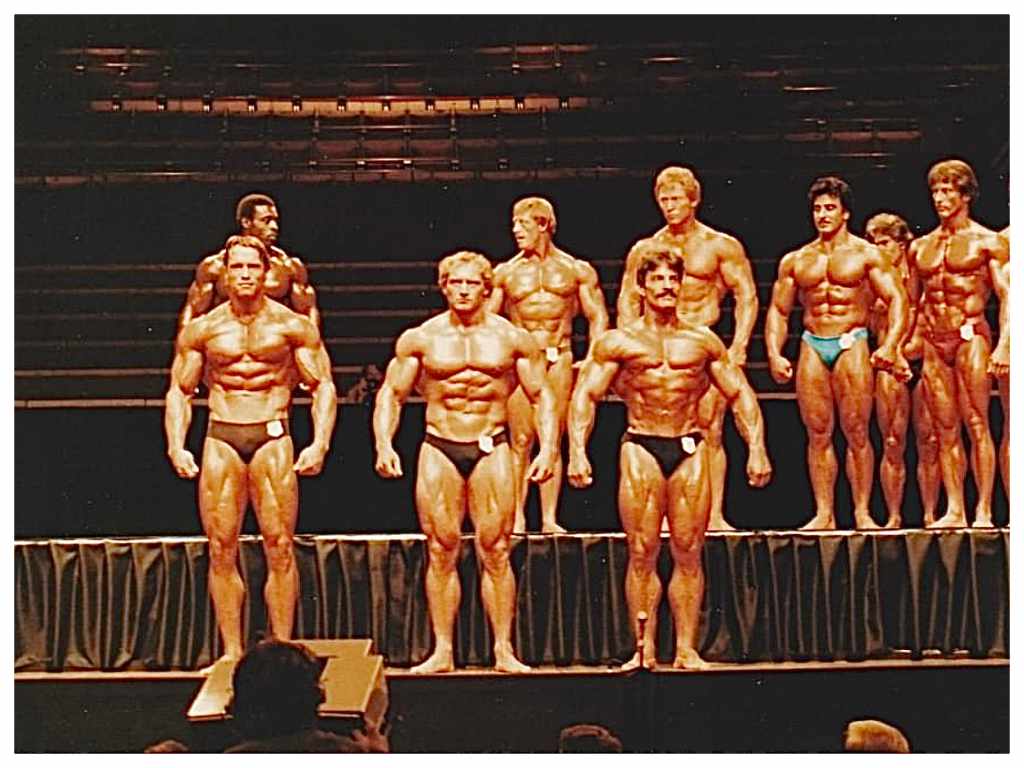
THE END RESULT! Roger and his ‘TONNES PER HOUR’ splits Arnold Schwarzenegger (Traditional Training) and Mike Mentzer (Heavy Duty Training). Roger received a tremendous reception from his hometown crowd. (Unpublished photo care of John Noonan).


